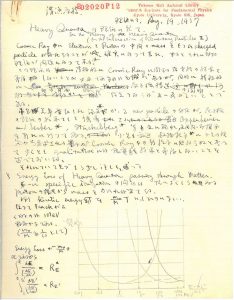Archive of historical materials

Talk: On the Theory of Heavy Quanta
OU1937-A3 (8 pages) Date: August 19, 1937
This note was prepared for the lecture to be given at RIKEN (The Institute of Physical and Chemical Research). On page 1, Yukawa explains the problems to address in a manuscript writing style and then outlines the past observation results and theories. He wrote somewhat in a speaking tone, such as “I must tell you that I recently …,” but unlike the lecture manuscripts written on manuscript paper, this memo only summarizes the computational logic forming process.
Yukawa said his motivation for this research came from the need for a theory that would describe the charged particles with the mass of halfway between the mass of an electron and that of a proton discovered in the cosmic ray observation and the need for the construction of a theory useful for the analysis of the nucleus structure. For Yukawa, those two objectives had to be addressed simultaneously. Yukawa began by examining the energy loss process in the cosmic-ray particle passing through a substance. He conducted analysis of the ionization in substance, radiation, scattering by the nucleus, capture into the nucleus, etc. systematically. In the summary section (latter half of page 3), Yukawa mentions that the electric charge can be +e or -e and that the mass is about 200 times that of an electron and the spin is either 0 or an integer. Why Yukawa did not consider the possibility of the spin being 1/2 (half-integer) is anyone’s guess. It was discovered later that the cosmic ray particle discovered at that time was a muon and its spin was 1/2.
From page 4, Yukawa wrote concretely about the interaction between the field of heavy quanta (U field) and the field of protons/neutrons and then elucidated their interaction toward forming his conclusion, as he felt the need for more detailed Hamiltonian in order to formulate the abovementioned theory of the cosmic-ray particles (heavy quanta). Yukawa stated that if the field of heavy quanta were a scalar field, the ground state of the deuteron in bound state of a proton and neutron would be in the P state, expressing his unsureness of what was correct. Today, we know that Yukawa’s heavy quantum (meson) is a pseudoscalar field. At the end of the note, Yukawa enumerated unsolved problems as his conclusion. (Written by Yutaka Hosotani)


